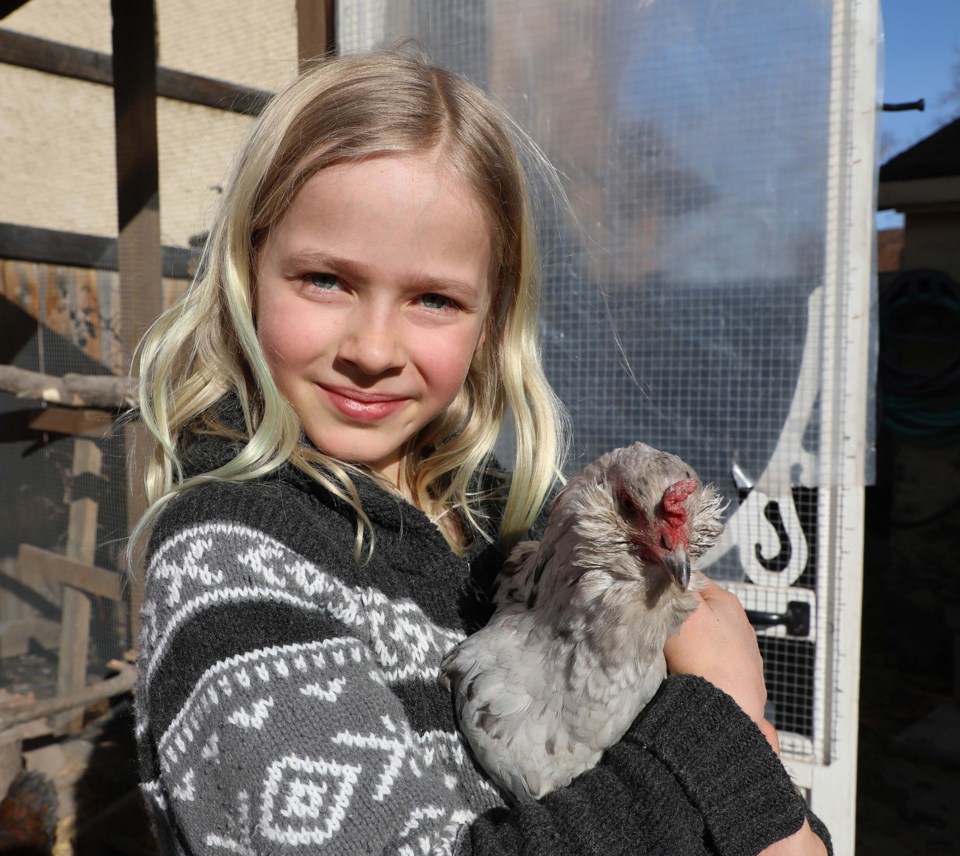A St. Albert girl wants city council to change its rules for backyard hens to keep birds like Marshmallow safe from harm.
Woodlands resident Alexandra Taphorn, 9, spoke to St. Albert city council March 15 about the city’s backyard chickens bylaw.
St. Albert legalized backyard hens in 2019 through its Hen Bylaw, which allowed residents to get a license to keep up to four hens per site.
In an interview, Taphorn said her family had four hens last year named Doodles, T-Rex, Henny Potter and Anastasia. She was particularly close with Anastasia and would often take her on walks with a leash or snuggle with her on a hammock.
When Anastasia died of a seizure, Taphorn brought in a hen named Marshmallow (so dubbed because she was white, cute and sweet) as a replacement. But because chickens establish pecking orders and react badly to strangers, the other three hens took to bullying and pecking at her.
“The first day she was there, she already had a bloody neck,” Taphorn said of Marshmallow.
Taphorn said she and her mother, Heidi, tried housing Marshmallow in a separate coop and applying coloured dyes and smelly ointments to the wound to deter the aggressors, but the pecking continued, and they feared for her life. After two months, they decided to give Marshmallow to another St. Albert hen owner.
“It was super sad,” Taphorn said.
Bigger flocks requested
The four-bird cap makes it extremely difficult to keep a flock healthy, Taphorn told council. A flock of four would drop to three after a death, endangering the group, as the hens would not produce enough body heat to survive winter. Introducing just one replacement created the risk of the others ganging up on it, as happened with Marshmallow.
“If the city had a rule that made dogs or cats suffer like this, it would be considered mean and inhumane,” Taphorn said.
Taphorn asked council to raise the maximum flock size to six, as that would let owners bring in two or more birds at once and reduce the odds of bullying. She and Heidi also suggested a minimum flock size of three, as chickens are social animals.
The City of Edmonton requires urban hen keepers to keep between three and six birds in their yards, as does Sturgeon County. Red Deer allows up to four chickens per home. Morinville has no specified cap, but limits chicken numbers based on breed, housing, property size and other factors, said Sgt. William Norton of the town’s protective services branch in an email.
Six is a pretty good size for a backyard flock, said Rico Sebastianelli, a show-chicken judge who lives near Bon Accord. Chickens are territorial and somewhat cannibalistic, and will go after strange birds and open wounds given the chance, he explained. That becomes less of a problem if you can introduce multiple birds at once, or if you keep the birds separated by a fence initially so they can get used to each other.
Coun. Jacquie Hansen gave notice after Taphorn’s presentation that she would move to have administration change the Hen Bylaw to allow for up to six hens per site and to make any other alterations to the law needed to protect animal health. Her motion will be debated later this year.
Heidi said backyard hens could help the city reach its environmental goals by providing local food production and reducing pesticide use – she uses hens instead of pesticides to control slugs and dew worms in her garden, for example.
Heidi said Marshmallow is healthy and laying eggs with her new flock.




